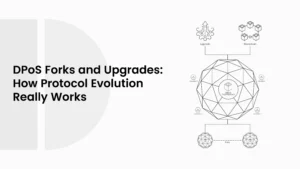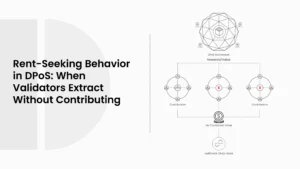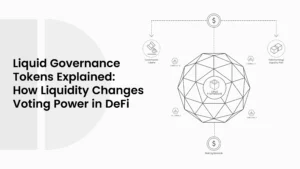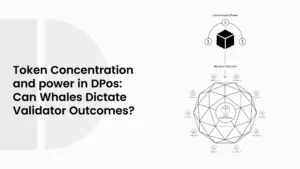The Future’s Here | How Multi-Chain DPoS Voting Could Optimize Electoral Processes
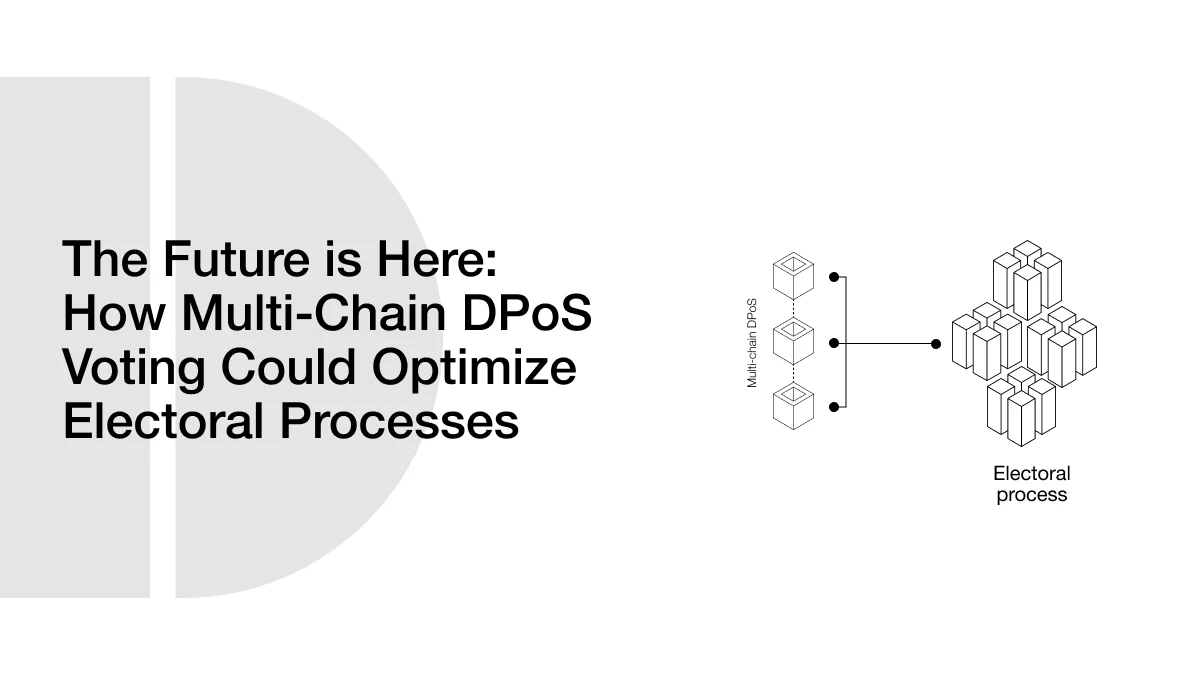
Voting plays a key role in shaping decisions in a country, company, or even an online community. However, many voting systems today are slow, unreliable, and not always secure. People worry about hacking, fake votes, or long wait times. That’s why more experts are looking at blockchain voting as a new way to optimize electoral processes.
- What Is Delegated Proof-of-Stake (DPoS)?
- Benefits of DPoS:
- Weaknesses of DPoS:
- What Is Multi-Chain Voting and Why Does It Matter?
- Why Does This Matter?
- Real-Life Implementation
- How Multi-Chain DPoS Voting Could Work
- Step 1: Voter Registers on a Trusted Chain
- Step 2: The Vote Is Sent to a Delegate
- Step 3: Cross-Chain Validation Happens
- Step 4: Results Are Counted and Stored
- Benefits of Multi-Chain DPoS Voting
- 1. Speed and Scalability
- 2. Better Security
- 3. Transparency and Trust
- 4. Cross-Platform Support
- 5. Lower Cost and Energy Use
- Multi-Chain DPoS vs Traditional Voting
- Real-World Example: A Cross-Chain National Election
- Step 1: States Use Different Blockchains
- Step 2: Voters Register and Choose Delegates
- Step 3: Casting the Vote
- Step 4: Cross-Chain Validation Begins
- Step 5: Final Results Are Posted Publicly
- Step 6: Audit and Feedback
- Technology and Tools Behind Multi-Chain DPoS Voting
- 1. Smart Contracts
- 2. Cross-Chain Bridges
- 3. Oracles
- 4. Nightshade Sharding (NEAR Protocol)
- 5. Delegated Proof of Stake (DPoS) Framework
- Challenges in Multi-Chain DPoS Voting
- How to Keep It Secure and Easy for Voters?
- 1. Use Strong Login Tools Like MFA
- 2. Give Each Voter a Private ID and Token
- 3. Build Simple Voting Apps
- 4. Create Transparent Delegate Ratings
- 5. Let Voters Check Their Vote Afterward
- 6. Have a Backup Plan
- The Future: How Governments and DAOs Might Use It
- Governments and National Elections
- International Voting and Global Events
- DAOs and Crypto Communities
- Schools, Cities, and Small Groups
- What Makes This All Possible?
- Final Thoughts
- Frequently Asked Questions (FAQs)
- Glossary of Terms
Blockchain can help because it keeps all votes in a secure and transparent system. Once a vote is recorded, it cannot be changed. This builds trust. One popular method used in blockchain voting is called Delegated Proof of Stake (DPoS). It’s faster and more energy-efficient than older systems like Proof of Work (PoW). It also empowers the people by letting them choose “delegates” to manage the vote.
But even DPoS has problems when used alone on just one blockchain. It can’t always handle large elections with many voters. It also struggles when different blockchain networks work together. That’s where multi-chain DPoS voting comes in. The future may see voting systems connecting multiple blockchains and using DPoS across them. It could make electoral processes faster, more secure, and more flexible. It would also allow more people to vote from different apps, wallets, or countries. That’s a big step forward.
This blog will explain how multi-chain DPoS voting works, why it’s important, what tools make it possible, and what the future may look like.
What Is Delegated Proof-of-Stake (DPoS)?
Delegated Proof of Stake, or DPoS, is a system used in many blockchains to ensure the safety and smooth operation of the network. In DPoS, holders of a coin or token on a blockchain can elect special individuals known as delegates (sometimes referred to as validators or witnesses). These representatives are responsible for validating blocks of information, such as transactions or votes, and then appending them to the blockchain.
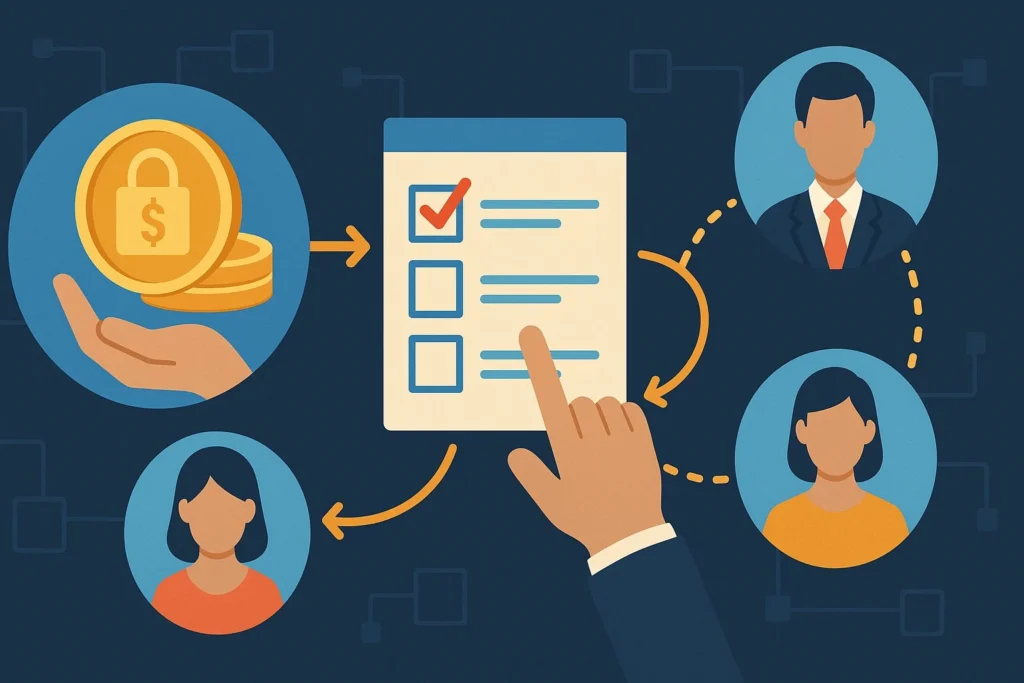
It works like this:
- You stake your tokens (lock them for a short time).
- You use your tokens to vote for someone you trust to manage the blockchain.
- The people with the most votes become delegates.
These delegates then do the hard work, like checking transactions and keeping the system running. If a delegate does a bad job, people can vote them out.
This is different from Proof of Work (PoW), where computers solve hard puzzles to earn the right to add a block. PoW takes a lot of energy and time. DPoS is much faster and doesn’t need huge machines or lots of electricity. It’s also different from Proof of Stake (PoS), where anyone who stakes tokens can become a validator. In DPoS, only a few are chosen to act on behalf of everyone else. That makes it more efficient.
Benefits of DPoS:
- Fast block times and transactions
- Low energy use
- People have control (you can vote in or out bad delegates)
- Suitable for systems with lots of users
Weaknesses of DPoS:
- Fewer validators can mean more centralization
- If people don’t vote, bad delegates might stay in power
- One blockchain only = limited use for big, global systems
Now consider the concept of DPoS applied across many interconnected blockchains. That’s the idea behind multi-chain DPoS voting.
ALSO READ: How DPoS and Modular Design Make Faster, Flexible, Secure, and Future-Proof Blockchains
What Is Multi-Chain Voting and Why Does It Matter?
Multi-chain voting allows individuals to vote on multiple blockchains. Rather than having everything on a single network, the system may be connected to numerous blockchains simultaneously. This concept can be of great assistance to large groups, such as countries, big companies, or world organizations. So to be clear, this is what it is. A single-chain system occurs entirely on a blockchain. That is easy to say, but it may lead to trouble. The system may become slow if too many people vote simultaneously. Or when a single chain has a bug or attack, the entire voting process is jeopardized.
Now think about multi-chain voting. It spreads the work across several blockchains. Each one handles its own part of the job. However, they still exchange information with clever tools such as bridges, oracles, and sharding. This is referred to as interoperability, or in other words, the ability of different chains to communicate with each other. As an example, voter sign-up could be on one blockchain. Another chain could handle vote casting. A third chain could take care of vote counting. And in the end, all of them connect the results. That’s what multi-chain DPoS voting aims to do.
Why Does This Matter?
-
More Voters, No Problem
Multi-chain systems can handle millions of votes at the same time without crashing or slowing down.
-
Better Security
If one chain has a problem, the others can still work. This reduces the risk of hacking or failure.
-
Faster Processing
Votes can be counted quickly because different parts of the system work in parallel (at the same time).
-
Flexible for Everyone
People using different wallets or apps can still join the vote. They don’t have to be on the same network.
-
Global Use
Different countries or states can use their own blockchains but still take part in the same election.
Real-Life Implementation
Think of multi-chain voting like a group project at school. Instead of one person doing all the work, you divide the work among team members. One writes, one edits, and one creates the slides. Then, you combine it all into one big presentation. It’s faster and more organized.
That’s why multi-chain voting is the future, especially when used with Delegated Proof of Stake (DPoS). DPoS keeps the system secure and fair, and multi-chain networks keep it fast and scalable.
ALSO READ: How Liquid Staking Derivatives Could Disrupt DPoS Economics (2025 Guide)
How Multi-Chain DPoS Voting Could Work
Having learned what DPoS and multi-chain voting are, it is time to discuss how the two concepts interact.
A DPoS voting system has multiple chains, where each blockchain performs a small amount of work in voting. Such an arrangement enables people to vote safely and in a limited period, regardless of their location. The special tools connect all the chains to allow data sharing, vote counting, and result verification in real time.
Let’s break it into four simple steps:
Step 1: Voter Registers on a Trusted Chain
A person who wants to vote logs into a blockchain app. This could be on Ethereum, NEAR, Cosmos, or any other chain that supports DPoS. The system checks their identity using multi-factor authentication (MFA) or biometric tools like a fingerprint. A smart contract then approves their voter status.
Step 2: The Vote Is Sent to a Delegate
After the voter is approved, they submit their vote. Instead of going straight to a central server, the vote goes to a delegate, a user chosen by others to confirm votes. This is how DPoS works. The delegate checks the vote and adds it to a block.
If the vote was cast on Chain A, and the vote data needs to be shared with Chain B, the system uses a bridge or oracle to move the information across safely.
Step 3: Cross-Chain Validation Happens
Now, the vote is being confirmed across multiple blockchains. Each chain is responsible for a part of the process:
- One chain verifies identity.
- Another chain collects and stores the vote.
- A third chain may check for fraud or fake users.
This is where interoperability matters. All chains must talk to each other using tools like:
- Bridges – to move data between chains.
- Oracles – to send trusted outside information.
- Sharding – to split work into smaller tasks to speed up the process.
A key example is Nightshade sharding, used by NEAR Protocol. It breaks big tasks (like vote counting) into smaller ones and completes them promptly.
Step 4: Results Are Counted and Stored
Once all votes are confirmed, they are counted across the system. Smart contracts running on each chain help keep everything fair. They also make sure no vote is changed or counted twice.
The final vote tally is recorded across all blockchains, and anyone can check it. This makes the system transparent and secure. And because the vote is stored on multiple chains, it’s nearly impossible to hack.
Benefits of Multi-Chain DPoS Voting
There are numerous benefits of using multi-chain DPoS voting as compared to traditional voting systems or even individual chain blockchain voting systems. It is made to fit the future where voting will have to be quick, just, and international.
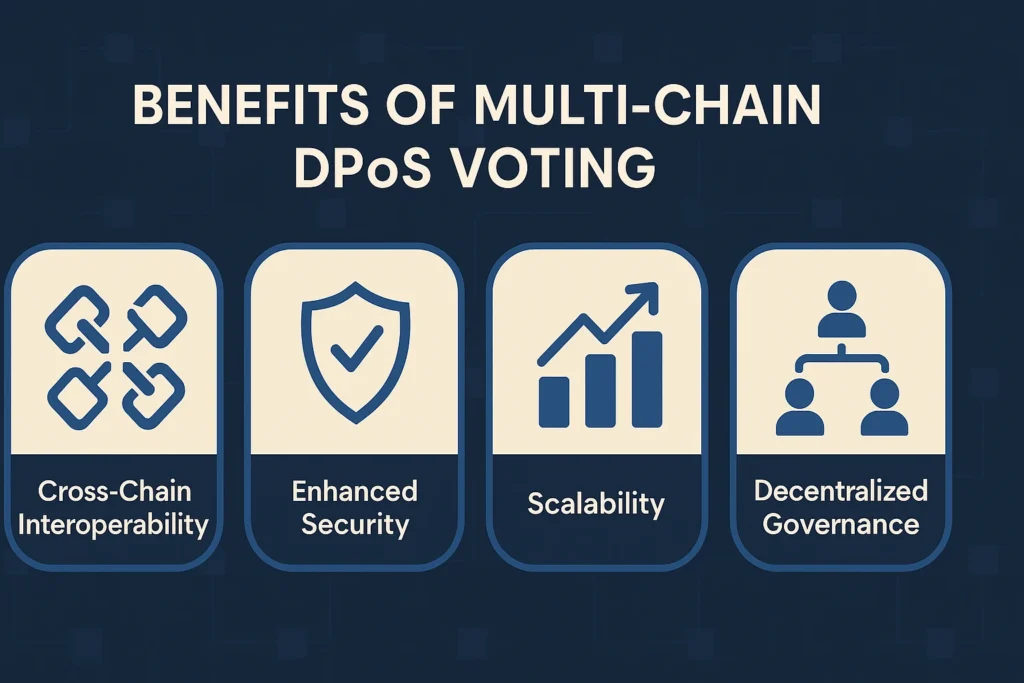
Let’s explore some of the top benefits.
1. Speed and Scalability
Multi-chain DPoS systems can handle millions of voters at once. That’s because the voting job is spread across many blockchains. With DPoS, only trusted delegates confirm votes, which makes the process even faster. Votes don’t pile up. Everything moves in real time.
2. Better Security
Votes are stored on multiple blockchains. If one chain gets attacked or goes offline, the others still keep the process running. This makes hacking nearly impossible. Also, smart contracts and cryptography ensure that each vote is locked in and can’t be changed.
3. Transparency and Trust
All data is public and easy to audit. Anyone can check the vote count. People don’t have to “hope” that votes were counted; they can actually see it. This builds more trust in the voting system.
4. Cross-Platform Support
Voters can join from different chains, wallets, or apps. You don’t need to be on one specific network. That makes the system more inclusive and user-friendly, especially for big countries or global organizations.
5. Lower Cost and Energy Use
Unlike older systems like Proof of Work, which need a lot of electricity, DPoS is lightweight. It uses less energy. Multi-chain setups also avoid overloading a single system, which reduces hardware needs and makes it more eco-friendly.
ALSO READ: How DPoS Builds Trust in Tokenized Real Estate, Art, and Gold
Multi-Chain DPoS vs Traditional Voting
| Feature | Traditional Voting | Single-Chain Blockchain Voting | Multi-Chain DPoS Voting |
| Speed | Slow, takes days | Medium, depends on one chain | Fast, across multiple chains |
| Scalability | Low, limited by location | Limited to network size | High, scales with connected chains |
| Security | Risk of fraud or hacks | Safer, but one point of failure | Very secure, data spread everywhere |
| Transparency | Low, behind closed doors | Medium, can be public | High, all votes are auditable |
| Energy Usage | None for paper, but slow | High (if PoW) | Low (uses DPoS and sharding) |
| User Access | In-person only | App-based, but chain-specific | Any wallet or app from any chain |
| Real-Time Results | No | Sometimes | Yes |
Real-World Example: A Cross-Chain National Election
Let’s imagine a big country called Blockland. It has 50 states and 100 million registered voters. The government wants to hold a fast, secure, and fair election using multi-chain DPoS voting. Here’s how it might work step-by-step.
Step 1: States Use Different Blockchains
Each state is free to choose its own blockchain. Some pick Ethereum; others use NEAR or Cosmos. A few choose faster, lighter chains like Avalanche or Polygon.
All these blockchains are part of the national voting system because they can talk to each other through bridges and oracles.
Step 2: Voters Register and Choose Delegates
Voters sign in to their local blockchain using a secure app. They prove their identity using multi-factor authentication (MFA), such as a password and facial recognition.
Once registered, they vote for delegates, trusted people who will help validate blocks of votes on their behalf. These delegates become part of the DPoS layer for their chain.
Step 3: Casting the Vote
Each voter casts a vote for their chosen candidate using their smartphone or computer. Their vote is:
- Encrypted
- Sent to a delegate
- Stored in a block on their state’s blockchain
If someone in Texas uses Ethereum and someone in New York uses Cosmos, both votes are still valid. The data is shared using cross-chain tools and stored in multiple places.
Step 4: Cross-Chain Validation Begins
Once voting ends, the system begins counting the votes:
- Smart contracts confirm that no one voted twice.
- Bridges move vote data between blockchains.
- Oracles verify that everything matches.
- Delegates from all chains work together to finalize the count.
Even if one chain slows down, the others keep the system running.
Step 5: Final Results Are Posted Publicly
After the votes are validated and counted, the results are:
- Stored on all connected blockchains
- Published in real time
- Available for public view through an open dashboard
Anyone, from journalists to regular citizens, can check the numbers.
Step 6: Audit and Feedback
Later, independent groups can audit the process by reviewing the public data. Voters can also log in and see that their vote was recorded, but without showing who they voted for (to keep things private).
The system learns from the experience and updates for the next election. Developers can even plug in new blockchains later, making the network grow over time.
Technology and Tools Behind Multi-Chain DPoS Voting
You might be wondering, “How does all this actually work?” The answer is: smart technology running in the background.
Multi-chain DPoS voting depends on a few key tools and systems that help everything stay safe, fast, and connected. Let’s take a closer look at the main ones.
1. Smart Contracts
Smart contracts are like digital agreements that run automatically. In voting, they make sure that:
- Only registered voters can vote
- No one can vote more than once
- Votes are recorded and locked forever
These contracts run on each blockchain and talk to each other to complete the full election process.
ALSO READ: How Regulatory Compliance in DPoS Dawns a New Era in Blockchain Governance
2. Cross-Chain Bridges
A bridge connects two different blockchains. Imagine a bridge between Ethereum and NEAR. It lets vote data move safely from one chain to another.
Bridges allow:
- Voters on one chain to send data to another
- Final results to be shared across all blockchains
- Systems to work together like one big voting network
3. Oracles
Oracles help smart contracts get information from outside the blockchain. They are trusted data messengers.
In voting, oracles help:
- Verify that registration dates or voting periods are correct
- Check if a voter has already cast a ballot
- Confirm that voting results match across chains
They make sure smart contracts have up-to-date facts to work with.
4. Nightshade Sharding (NEAR Protocol)
Sharding means breaking big jobs into smaller parts. Nightshade sharding is a method used by NEAR Protocol. It makes voting faster and more scalable.
Here’s how it helps:
- Each shard handles part of the voting traffic
- Multiple shards work at the same time
- The network never slows down, even if millions vote
Think of it like many checkout lanes at a busy store; no one has to wait in a long line.
5. Delegated Proof of Stake (DPoS) Framework
This is the heart of the system. People vote for delegates (trusted validators) who confirm and store votes.
DPoS keeps things:
- Fast – only a small group confirms blocks
- Secure – bad delegates get removed
- Fair – anyone can vote for who represents them
In a multi-chain system, delegates work across blockchains, helping each one stay in sync.
| Tool | What It Does |
| Smart Contracts | Automate voting rules and confirm each vote |
| Cross-Chain Bridges | Connect different blockchains and transfer vote data |
| Oracles | Provide real-world info to smart contracts |
| Nightshade Sharding | Speeds up the voting process by breaking it into smaller parts |
| DPoS Framework | Let voters choose trusted delegates to confirm votes |
| MFA + ECDSA | Keeps voters and their votes safe from hacking or fraud |
Challenges in Multi-Chain DPoS Voting
| Challenge | Why It Matters | Possible Fix |
| Cross-chain issues | Data may get lost or delayed | Strong bridges, tested protocols |
| Bad delegates | Can cheat or block the system | Voting rewards + removal tools |
| Too complex for users | People may not trust what they don’t understand | Simple apps + voter education |
| No legal rules yet | Can’t use for elections legally | Governments need to create digital voting laws |
| Delegate centralization | Few people get too much control | Voting limits + term limits |
| High costs | Small groups can’t afford it | Open-source tools + government support |
How to Keep It Secure and Easy for Voters?
- A sound voting system must do two things:
- Keep every vote safe
- Make it easy for people to use
With multi-chain DPoS voting, the technology is strong.
Here are some ways to make that happen:
1. Use Strong Login Tools Like MFA
Voter login must be secure but not stressful. The system should use:
- MFA (Multi-Factor Authentication) – like a password + face scan
- Biometric login – fingerprint or voice
- QR codes – easy for mobile users
These tools stop fake voters from joining the system and protect real users.
2. Give Each Voter a Private ID and Token
Every voter gets:
- A unique ID for that election
- A voting token that can’t be copied
These tools make sure each person votes only once. The token disappears after use, like a real ballot box that closes after your vote is in.
3. Build Simple Voting Apps
Most people aren’t tech experts. So, voting apps should be:
- Easy to install on any device
- Written in clear language (no blockchain jargon)
- Include help buttons, chat support, or video guides
The goal: Anyone should be able to vote in under 5 minutes, no matter their tech skills.
4. Create Transparent Delegate Ratings
DPoS depends on trusted delegates, so people should be able to see:
- Who they are
- How they were voted in
- Their past performance (good or bad)
A rating or score system helps voters make informed choices, and bad actors can be voted out quickly.
5. Let Voters Check Their Vote Afterward
Once someone votes, the system should give them a way to:
- Check that their vote was recorded
- Confirm that it wasn’t changed
- Do this without showing who they voted for (to protect privacy)
This helps build trust and transparency in the system.
6. Have a Backup Plan
Even the best tech can fail. So every system must have:
- Offline backup options
- Emergency contact support
- Clear steps if someone loses access to their device
That way, no one gets locked out of the election.
The Future: How Governments and DAOs Might Use It
Multi-chain DPoS voting isn’t just for tech fans or blockchain developers. In the future, this system could change how governments, online communities, and global groups make big decisions.
Let’s look at who might use it and how.
Governments and National Elections
Right now, most elections use paper ballots or simple online forms. But in the future, countries could use blockchain-powered DPoS voting to:
- Hold presidential elections
- Let citizens vote on new laws or taxes
- Run smooth and fast elections across many states or regions
Each state could use its own blockchain. But with cross-chain tools, all the results would be counted together, fairly and in real-time.
This would help governments:
- Save money on ballots, machines, and staff
- Cut down fraud
- Include more voters, especially those overseas or with disabilities
Example: A country like the U.S. could let people vote from home using secure mobile apps. Each vote would go through a local blockchain, and final results would be collected across all 50 states.
International Voting and Global Events
Imagine a global climate group asking millions of people from around the world to vote on a new sustainability rule.
With multi-chain DPoS voting:
- Users in Europe could vote on Polkadot
- Users in Asia could vote on NEAR
- Users in Africa could vote on a local blockchain
No matter the location or chain, all votes would come together and be counted the same way. This means global voting is not only possible, it’s faster and fairer than ever before.
DAOs and Crypto Communities
A DAO (Decentralized Autonomous Organization) is an online group that makes decisions using blockchain votes. Right now, most DAOs use basic token voting. But with multi-chain DPoS voting, DAOs could:
- Let members vote from any chain they use
- Elect cross-chain delegates to manage funds or vote on code updates
- Share votes with other DAOs to work together on big projects
This makes DAO voting:
- More inclusive
- Less dependent on one token or network
- Easier to scale as the community grows
Example: A global art DAO could let members vote using Ethereum, Solana, or Avalanche wallets, without leaving their app.
Schools, Cities, and Small Groups
It’s not just for big groups. Even schools, towns, or clubs could use DPoS voting to:
- Elect student councils
- Decide local budgets
- Vote on community rules
A small network of trusted delegates can run the system, and results stay secure without needing expensive tools.
What Makes This All Possible?
- Cross-chain tools (bridges, oracles)
- Fast validation using DPoS
- Secure digital ID systems
- User-friendly apps
As these tools grow, the use of multi-chain DPoS voting will become common, not rare.
Final Thoughts
The world is moving into a new era where technology and trust need to go hand in hand. Voting is one of the most important parts of a strong and fair society. But traditional voting systems are often slow, unsafe, or hard to access. Multi-chain DPoS voting could be the ultimate solution. It also solves one of blockchain’s biggest problems: being stuck on one chain. With multi-chain setups, voters from all over the world and across many blockchains can take part together.
Yes, there are challenges like technical complexity, legal questions, and bad actors. But with the right tools, education, and laws, these problems can be fixed. Whether it’s used in national elections, global events, or small online communities, multi-chain DPoS voting could shape the future of democracy and digital decision-making. And that future might be closer than you think.
Frequently Asked Questions (FAQs)
Q1: What is multi-chain DPoS voting?
Multi-chain DPoS voting is a way to vote across multiple blockchains simultaneously. It uses trusted people called delegates to manage votes and ensure fairness and security.
Q2: How is DPoS different from regular voting?
In DPoS, people vote for delegates who then confirm the votes. It’s faster and safer than older methods, and you don’t need big machines or paper ballots.
Q3: Can I vote from different apps or wallets?
Yes! That’s the power of multi-chain. You can vote from any wallet or app that supports the system, even if it’s built on a different blockchain.
Q4: Is it secure?
Yes. Votes are locked using smart contracts and digital signatures. No one can change them, and everything is easy to verify.
Q5: Will governments use this in the future?
They might. Many countries are testing blockchain voting systems. Multi-chain DPoS could help make those systems fast, fair, and global.
Glossary of Terms
DPoS (Delegated Proof of Stake): A system where people vote for trusted delegates who confirm transactions or votes.
Multi-Chain: A setup where many blockchains work together at the same time.
Smart Contract: A computer program that runs automatically when certain conditions are met.
Delegate: A person or node chosen by others to manage the voting or transaction process.
Bridge: A tool that connects two blockchains so they can share data.
Oracle: A service that brings outside data into a blockchain system.
Sharding: Breaking a big job into smaller pieces to make it faster.
MFA (Multi-Factor Authentication): A login method that uses more than one way to check your identity.
ECDSA: A type of digital signature that keeps votes or data secure.
DAO (Decentralized Autonomous Organization): An online group that makes decisions using blockchain-based voting.

